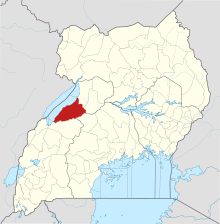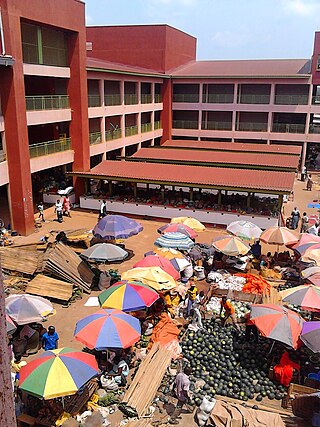

Mparo Royal Tombs also Mparo tombs is a historical royal burial site for Omukama Kabalega II and kings and royals of Bunyoro-Kitara kingdom. [1] [2] [3] [4] [5] [6] The tombs cover six acres of land. [7] [8]


Mparo Royal Tombs also Mparo tombs is a historical royal burial site for Omukama Kabalega II and kings and royals of Bunyoro-Kitara kingdom. [1] [2] [3] [4] [5] [6] The tombs cover six acres of land. [7] [8]

Mparo royal tombs is located along the Hoima-Masindi highway in Mparo village, Mparo division approximately 4kmnortheastst of Hoima town in Hoima district, Western Uganda. [1] [2] [9] [7] [10] [11]

In Front of the tombs is a white and black painted cone-shaped monument built when Sir Emin Pasha met Kabalega in 1871 for the first time to tell him accept British rule. [1] [12] [6] [13] [14] It is made of 12 steps upward. [7]
The Mparo royal tombs is a round-grass thatched huts with reeds having wooden doors guarded by royal guards. [1] [6]
Bunyoro-Kitara kingdom has various royal sites each occupying eight square mile of land. Some of the tombs found in these sites include the Kabalega tomb, Tito Winyi tomb who was the father of Omukama Solomon Gafabusa and others. [1]

The Mparo royal tombs are burial grounds for various royal figures in the Bunyoro-Kitara kingdom. The tombs houses the remains of Omukama Chwa II Kabalega who ruled Bunyoro kingdom in the 19th century. Omukama Kabalega II was exiled to Seychelles in April 1899 by British Empire for resisting colonial rules. [1] [2] [9] [7] [3] [5] [10]
The Mparo royal tombs is also the final resting place for the remains of Sir Tito Winyi, father to the Omukama Solomon Gafabusa Iguru I, current Omukama. [12] [15] [16] It's also burial grounds for the princess, princesses and other royals of Bunyoro-Kitara Kingdom. [1] [2]
The remains of Kabalega are kept in a traditional mausoleum covered with bark cloth. [6] [10] Each tomb at Mparo royal tombs is covered with a bark-cloth next to the royal regalia and other cultural belongings of the respective kings which he used during his regime. [1] [2] [9] [15]
The Mparo royal tombs are tourist attractions having ancients instruments such as smoking pipes, clay pots, milk and water containers, baskets, wooden bowls, sticks, drums, spears, shields, wooden stools and coffee berries. [1] [7] [17] [12] [18] [14]
People visit the Mparo royal tombs to perform cultural rituals and also to pay homage to the former kings and pray for inspiration, and blessings from the spirits Omukama Kabalega and other kings. [1] [12] [19]
The tombs also houses the bronze and iron spears got from the Chwezi and Babito dynasties, the cone-shaped crowns, flutes and necklaces used by the rulers of chwezi dynasty. [1]

People visiting the tombs are not allowed to enter with shoes, he or she should not have engaged in extramarital affairs the night prior visiting. Girls/women who are undergoing menstruations periods are not allowed to enter. [12] Also for one to step into the tombs, your required to confess his/her sins. [6]
in 2009, the tombs were rehabilitated by Uganda People's Defense Force (UPDF) in preparation for the Heroes day celebration in June 2009 which were hosted by the Bunyoro kingdom. The soldiers renovated the traditional huts and tombs inside the Bunyoro empire and also constructed the perimeter wall replacing the reed fence with a perimeter wall of concrete and bricks. [1] [8] [19]

Bunyoro, also called Bunyoro-Kitara, is a traditional Bantu kingdom in Western Uganda. It was one of the most powerful kingdoms in Central and East Africa from the 16th century to the 19th century. It is ruled by the King (Omukama) of Bunyoro-Kitara. The current ruler is Solomon Iguru I, the 27th Omukama.
Omukama wa Bunyoro is the title given to rulers of the East African kingdom of Bunyoro-Kitara. The kingdom lasted as an independent state from the 16th to the 19th century. The Omukama of Bunyoro remains an important figure in Ugandan politics, especially among the Banyoro people of whom he is the titular head. He is closely related to the Omukama of Tooro Kingdom.

The Tooro Kingdom is a Bantu kingdom located within the borders of Uganda. The current Omukama of Tooro is King Oyo Nyimba Kabamba Iguru Rukidi IV. King Oyo Nyimba Kabamba Iguru Rukidi IV took to the throne of Tooro kingdom in 1995 at the age of just three years, after the death of his father Omukama Patrick David Matthew Kaboyo Rwamuhokya Olimi III on August 26, 1995, at the age of 50.
Rukirabasaija Omukama Oyo Nyimba Kabamba Iguru Rukidi IV, commonly known as King Oyo, is the reigning Omukama of Tooro, in Uganda. He was born on 16 April 1992 to King Patrick David Mathew Kaboyo Olimi III and Queen Best Kemigisa Kaboyo. Three and a half years later in 1995, Oyo ascended the throne and succeeded his father to become the 12th ruler of the 180-year-old Kingdom of Tooro.

Hoima is the second capital of Uganda. It is the main municipal, administrative, and commercial center of Hoima District. It is also the location of the palace of the Omukama of Bunyoro.

Kitara was an ancient legendary state that covered significant parts of western Uganda and is regularly mentioned in the oral traditions of the Banyoro, Batooro and Banyankole.

King’s College Budo is a mixed, residential, secondary school in Central Uganda (Buganda).
Chwa II Kabalega, was the King or Omukama of Bunyoro in Uganda from 1870 to 1899.

Henry Muganwa Kajura, commonly known as Henry Kajura, is a Ugandan administrator and politician. Until 2016 he served as the First Deputy Prime Minister and Minister of Public Service in the Cabinet of Uganda.
Omukama Rukirabasaija Agutamba Solomon Gafabusa Iguru I is the 27th Omukama of Bunyoro from 1994 to present. The King's traditional alternative name used by family is Amooti.
Kinyara Sugar Limited (KSL) formally Kinyara Sugar Works Limited (KSWL), is a sugar manufacturer in Uganda.
The Bugoma Forest is a protected tropical forest that is situated southwest of Hoima and northeast of Kyenjojo towns, and east of Lake Albert, in the Hoima district of western Uganda. It was gazetted in the 1932 and came under the mandate of the National Forestry Authority in 2003. But it was expanded in 1965, 1968 and 1998. Its surface area is given as between 41,144 hectares (411.44 km2) and 65,000 hectares (650 km2).
Wasswa Chwamale Mwanga Winyi was a reigning monarch of Bunyoro-Kitara during the period circa 1300 AD. His chief palace was located at Kibulala, Ssingo, where his remains are buried today. When Prince Kalemeera of Buganda, the only son of Ssekabaka Chwa Nabakka, was exiled to Bunyoro, he took refuge at the palace of his paternal uncle, Winyi I at his palace in Kibulala. There he committed more transgressions, fathering Prince Kimera Walusimbi with Lady Wannyana, his uncle's chief wife. Prince Kimera later became the third Kabaka of Buganda.
Kabalega International Airport, also Hoima International Airport, is an airport under construction in Hoima District, Uganda. It is part of the infrastructure under construction as Uganda prepares to develop its nascent petroleum industry. When completed, it would be Uganda's second international airport, besides Entebbe International Airport. The new airport is expected to facilitate mobilization of equipment for construction of the Uganda Oil Refinery and assist in the development of agriculture and tourism in Uganda's Western Region.
Mparo may refer to one of the following:

Mparo is a Division in Hoima City, in the Western Region of Uganda. It is the location of the "Mparo Tombs", one of the Royal burial sites of the Bunyoro Kingdom.

Kitara FC is also known as Kitara Football Club or The Royals, is a Ugandan football club found in Hoima City. It plays among the top division of Uganda football league known as Uganda Premier League and Kitara fc is the current winner of Uganda cup.

The Kangai-Kabalega monument is a white and blue painted landmark which marks the spot where Kabaka Mwanga and Omukama Kabalega were captured by the British colonialists in 1899.
The Otole dance is a traditional war dance of the Acholi people. Its purpose is to teach young Acholi what to expect from fights with rival ethnic factions or groups neighboring their territory. This war dance encompassed men ranging from 30-50 years including strong women. When the British invasion in Bunyoro Kingdom happened, the Acholi chief then Chief Awich Abok of Payira offered protection to Kabalega the Bunyoro king in Acholiland.
Kyakapeya is a village in Hoima City in Western region of Uganda is located in Hoima city 4km from hoima town on Hoima-Masindi Road. Bunyoro-Kitara Kingdom's.
{{cite web}}: CS1 maint: numeric names: authors list (link)